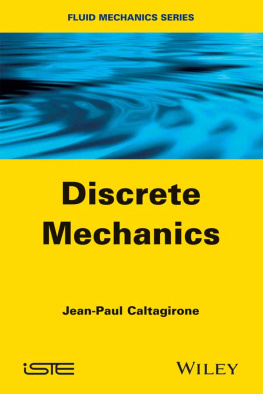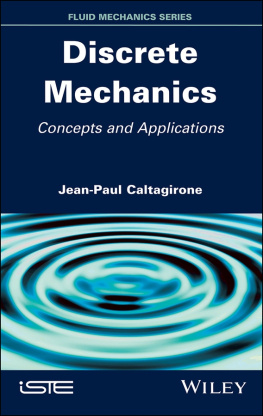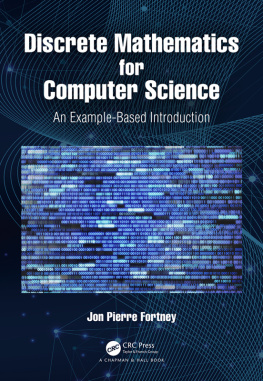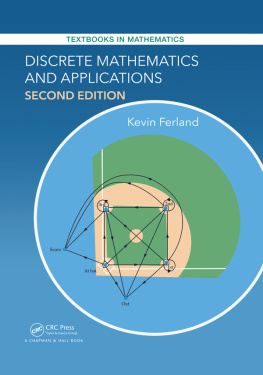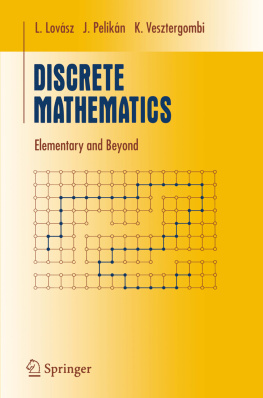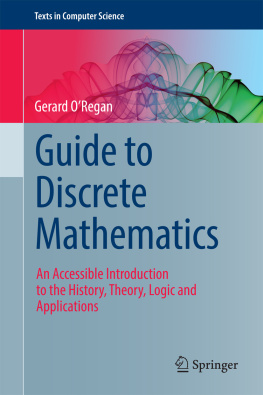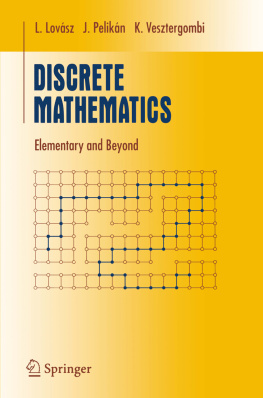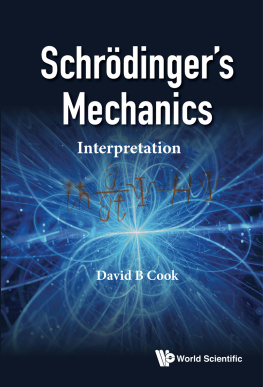Caltagirone - Discrete Mechanics
Here you can read online Caltagirone - Discrete Mechanics full text of the book (entire story) in english for free. Download pdf and epub, get meaning, cover and reviews about this ebook. City: Hoboken;NJ, year: 2015;2014, publisher: John Wiley & Sons, Incorporated, genre: Computer. Description of the work, (preface) as well as reviews are available. Best literature library LitArk.com created for fans of good reading and offers a wide selection of genres:
Romance novel
Science fiction
Adventure
Detective
Science
History
Home and family
Prose
Art
Politics
Computer
Non-fiction
Religion
Business
Children
Humor
Choose a favorite category and find really read worthwhile books. Enjoy immersion in the world of imagination, feel the emotions of the characters or learn something new for yourself, make an fascinating discovery.
- Book:Discrete Mechanics
- Author:
- Publisher:John Wiley & Sons, Incorporated
- Genre:
- Year:2015;2014
- City:Hoboken;NJ
- Rating:5 / 5
- Favourites:Add to favourites
- Your mark:
- 100
- 1
- 2
- 3
- 4
- 5
Discrete Mechanics: summary, description and annotation
We offer to read an annotation, description, summary or preface (depends on what the author of the book "Discrete Mechanics" wrote himself). If you haven't found the necessary information about the book — write in the comments, we will try to find it.
Discrete Mechanics — read online for free the complete book (whole text) full work
Below is the text of the book, divided by pages. System saving the place of the last page read, allows you to conveniently read the book "Discrete Mechanics" online for free, without having to search again every time where you left off. Put a bookmark, and you can go to the page where you finished reading at any time.
Font size:
Interval:
Bookmark:


First published 2015 in Great Britain and the United States by ISTE Ltd and John Wiley & Sons, Inc.
Apart from any fair dealing for the purposes of research or private study, or criticism or review, as permitted under the Copyright, Designs and Patents Act 1988, this publication may only be reproduced, stored or transmitted, in any form or by any means, with the prior permission in writing of the publishers, or in the case of reprographic reproduction in accordance with the terms and licenses issued by the CLA. Enquiries concerning reproduction outside these terms should be sent to the publishers at the undermentioned address:
ISTE Ltd
27-37 St Georges Road
London SW19 4EU
UK
www.iste.co.uk
John Wiley & Sons, Inc.
111 River Street
Hoboken, NJ 07030
USA
www.wiley.com
ISTE Ltd 2015
The rights of Jean-Paul Caltagirone to be identified as the author of this work have been asserted by him in accordance with the Copyright, Designs and Patents Act 1988.
Library of Congress Control Number: 2014955856
British Library Cataloguing-in-Publication Data
A CIP record for this book is available from the British Library
ISBN 978-1-84821-678-5
Preface
The law of dynamics stated by Isaac Newton in 1686 in his treatise PhilosophiNaturalis Principia Mathematica [NEW 87] introduces the vectorial nature of both sides of that law: the force and the quantity of acceleration. For Newton and his contemporaries, the concepts of vectors and scalars applied to rectilinear trajectories were not so different. The composition of the motions helps to extend those motions along their plane or in space, and Newton himself adds forces to them (see Corollaries I and II of the Principia).
The establishment of the equations of general motions in around 1740 by Euler, Lagrange and MacLaurin, introduced the concept of fixed directions in space, where the vectors, velocity and acceleration could be expressed in the form of coordinates. In the field of Mechanics today, we still use the fundamental bases introduced by these concepts. The work of Truesdell illustrates the rise and trajectory of this discipline, to which Truesdell himself contributed greatly during the last century, bringing together the concepts of mechanics with those of thermodynamics; up until that point, the two disciplines had developed in parallel, independently of one another.
Newtons vision, which some might consider to be restrictive, is, in fact, remarkable. He considered a vector as an oriented bipoint i.e. two points connected by an edge, with its direction being clearly defined. The intensity of the velocity vector can then be calculated, if we introduce the concept of time. A more commonplace and contemporary view can be constructed by considering a road, running between two roundabouts. The driver of a vehicle traveling on that road does not need to know the direction of the journey at a large scale the local direction of travel is clearly determined by the road itself. Until the driver reaches the next roundabout, his/her direction of travel will be the direction of that particular road, and his/her speed can be calculated as being the distance between the two roundabouts over the travel time. When the next roundabout is reached, the driver will need to continue the journey in a particular direction by choosing the most appropriate exit. Hence, the vehicles speed on the portion of road between the two roundabouts can be considered to be the component of the velocity vector, projected along the direction of the piece of road. The mean velocity along that portion of road can be calculated as the integral of the vehicles acceleration over that stretch of road. Furthermore, the journeys made over several successive stretches of road can be added together in the same way that vectors can. Based on these elementary considerations, it is possible to construct a discrete theory of motion, based on Newtons law.
In a Galilean frame of reference, a single material point is at rest or has uniform rectilinear motion, and the laws of mechanics are invariant, regardless of whether the frame of reference changes. The motion of uniform rotation is, a priori, a particular case, set apart from the category of Galilean frames of reference, in that an additional force of inertia, stemming from the centrifugal acceleration, is also present. Yet the fundamental law of dynamics still remains valid and applicable to this type of motion. As is the case with gravity, the centrifugal forces derive from a scalar potential which, at all times and at all points, compensates for these purely kinematic effects. Such is the case for an object or person on a carousel, subject simultaneously to centrifugal and centripetal forces, which balance one another out exactly to keep the subject stationary within a rotating frame of reference. An isolated observer on Earths surface does not feel the effects of the planets rotation. Hence, in the presence of a force deriving from a scalar potential, a Galilean frame of reference can be deemed to be inertial; such is the case with gravity if density is constant. Other types of force do not contribute directly to acceleration; for instance, a spherical drop subject to capillary forces deriving from a potential (the capillary pressure) will not be subject to acceleration, and will remain in a state of static equilibrium. Hence, not all the forces contribute to the modification of the state of a system; some of them those which derive from a scalar potential are counteracted exactly by that potential, and the resulting acceleration is null. Generally speaking, a force derives from two potentials: one scalar and the other vectorial. The vectorial potential alone is responsible for the acceleration of the medium. For a closed system, animated with a uniform translational or rotational motion, the total energy contained in the system must be conserved as that system evolves. In particular, if the system were stationary to begin with, it could not spontaneously begin to move. This physical principle is, at once, a curse and a blessing: uniform motions defy any description by Newtons law of dynamics, but by that token, we are able to forget about the kinematic history of the system; in particular, we do not need to know where a particle has come from if we know its current position. It is, however, important to know the history of the stresses undergone by the system during the course of its motion, so as to be able to predict the restitution of any energy that has been accumulated. The immediate consequence of this is that these uniform motions do not contribute to the accumulation of the aforementioned stresses.
Thus, here, the idea of using a fixed, absolute frame of reference to construct a vectorial representation is no longer useful. The velocity and acceleration are, at once, directed vectors and scalars, which represent the measurement of the vectors. The question then arises of which frame of reference to choose; strictly speaking, in that the scalar product is the same regardless of the chosen base, the choice of the frame of reference is unimportant. It is possible to express all the forces involved in the fundamental law of dynamics using solely the velocity components defined on each edge. Hence, even if the velocity vector exists in a particular frame of reference, there is absolutely no need to represent it. Similarly, the acceleration will only be observed by way of its projection onto the edge in question. Stokes theorem leads us to expect such a possibility; indeed, the rotational of a vector on a surface is equal to the circulation of that same vector, projected onto the path underlying the surface, i.e. the circulation of its components. Those components can be considered to be the geometric projection of the velocity, which it is not necessary to know.
Next pageFont size:
Interval:
Bookmark:
Similar books «Discrete Mechanics»
Look at similar books to Discrete Mechanics. We have selected literature similar in name and meaning in the hope of providing readers with more options to find new, interesting, not yet read works.
Discussion, reviews of the book Discrete Mechanics and just readers' own opinions. Leave your comments, write what you think about the work, its meaning or the main characters. Specify what exactly you liked and what you didn't like, and why you think so.

